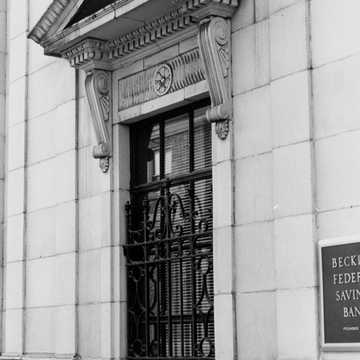You are here
Beckley Federal Savings Bank (Beckley National Bank)
This showy, small-scale temple of finance, executed in stone and terra-cotta, is uptown's architectural gem. The design shows what can happen when an architect knows classical motifs well enough to arrange them with flair; it also demonstrates how well a building can address both streets at a major intersection. Above a cool gray granite podium, the bank displays the warm, tawny hue so typical of Beckley's buildings. The Main Street front has a pedimented entrance between three-quarter Ionic columns framed by end walls, or antae. On the five-bay Fayette Street elevation, pediments supported on consoles top the first-floor windows on the two end bays. Between, three central bays defined by shallow, fluted Ionic pilasters contain huge arched windows with beautifully detailed metal sash. Above a full entablature and a paneled terra-cotta parapet, a square attic with ornamental acroteria acts as a base for a drum and low saucer dome. Although interior fittings have been altered, the basic architecture of the banking room remains.
Bates outdid himself in this commission, which recalls the Lynchburg (Virginia) National Bank (1915–1916) by Alfred Bossom, America's preeminent bank architect of the early twentieth century. Bates also designed the Raleigh County Bank (now United National Bank), diagonally across the intersection, and the Beckley Presbyterian Church.
Writing Credits
If SAH Archipedia has been useful to you, please consider supporting it.
SAH Archipedia tells the story of the United States through its buildings, landscapes, and cities. This freely available resource empowers the public with authoritative knowledge that deepens their understanding and appreciation of the built environment. But the Society of Architectural Historians, which created SAH Archipedia with University of Virginia Press, needs your support to maintain the high-caliber research, writing, photography, cartography, editing, design, and programming that make SAH Archipedia a trusted online resource available to all who value the history of place, heritage tourism, and learning.

